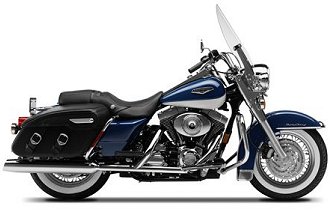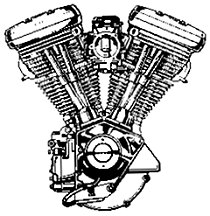 For a lot of us, Harley-Davidsons haven't been technologically interesting. The fact is, the name is more or less synonymous with "old-tech." They only a few years ago discovered opposed piston brakes, you know? For most of their history, The Motor Company has seemed to prefer the farm implement look and feel. Harleys have tended to be crudely made, roughly finished and despite recent innovations such as mapped ignition and fuel injection, decidedly pokey. Yet they continue to attract new adherents among technologically-literate riders. Why? I can think of three reasons.
For a lot of us, Harley-Davidsons haven't been technologically interesting. The fact is, the name is more or less synonymous with "old-tech." They only a few years ago discovered opposed piston brakes, you know? For most of their history, The Motor Company has seemed to prefer the farm implement look and feel. Harleys have tended to be crudely made, roughly finished and despite recent innovations such as mapped ignition and fuel injection, decidedly pokey. Yet they continue to attract new adherents among technologically-literate riders. Why? I can think of three reasons.
Reason number one is of course that for many, a Harley-Davidson is one way to slow life down a little. The product is valid from that viewpoint alone, whatever you expect from technology. The chuff-chuff of a pushrod-engined Harley-Davidson as it goes about its business may not be accompanied by much velocity, but it surely gets the job done, and just how fast can you reasonably go on today's roads anyway? At the risk of something approaching heresy, let me say there is something to be said for unhurried, un-racer-like transport.
 The second reason may have something to do with the acceptance of the Harley-Davidson engine among the motorcycle industry's performance elite. Tuning wizards such as Byron Hines are said to be spending nearly all their time on Harleys these days (entirely aside from the V-Rod project). Some really good engineering is trickling down from such performance leaders as Nascar, and the Harley-Davidson Evolution Big Twin motor, whose 14-year production run ended a few seasons ago, is finally being ushered into the modern world, by a growing network of aftermarket artisans. Sure, Harley-Davidsons have made big horsepower before, but outside of a small cadre of professional engine tuners, such exercises have been technological flukes; short-lived and even shorter-fused; unpredictable, unrideable and unreliable Frankenstein's monsters of internal combustion. They haven't been the products of reasoned, deliberate effort, and certainly not projects you would want to ride cross-country. All that has changed. A sort of paradigm shift has occurred in the Harley performance world as scores of shops all over the country are busily turning out 150-hp naturally-aspirated Evos and clones that if anything are more civilized and more streetable -- and get this -- smoother running -- than stock; engines whose performance character owes absolutely nothing to Milwaukee. Ever think a Big Twin streetbike could sound and accelerate like a piped V-Max? It's something you've got to experience to believe, and it's causing a lot of people to suddenly have more respect for the old Bar and Shield.
The second reason may have something to do with the acceptance of the Harley-Davidson engine among the motorcycle industry's performance elite. Tuning wizards such as Byron Hines are said to be spending nearly all their time on Harleys these days (entirely aside from the V-Rod project). Some really good engineering is trickling down from such performance leaders as Nascar, and the Harley-Davidson Evolution Big Twin motor, whose 14-year production run ended a few seasons ago, is finally being ushered into the modern world, by a growing network of aftermarket artisans. Sure, Harley-Davidsons have made big horsepower before, but outside of a small cadre of professional engine tuners, such exercises have been technological flukes; short-lived and even shorter-fused; unpredictable, unrideable and unreliable Frankenstein's monsters of internal combustion. They haven't been the products of reasoned, deliberate effort, and certainly not projects you would want to ride cross-country. All that has changed. A sort of paradigm shift has occurred in the Harley performance world as scores of shops all over the country are busily turning out 150-hp naturally-aspirated Evos and clones that if anything are more civilized and more streetable -- and get this -- smoother running -- than stock; engines whose performance character owes absolutely nothing to Milwaukee. Ever think a Big Twin streetbike could sound and accelerate like a piped V-Max? It's something you've got to experience to believe, and it's causing a lot of people to suddenly have more respect for the old Bar and Shield.
Reason number three is equally intriguing: The stock item is also rapidly improving. Thanks in large part to pressure from aftermarket innovators, Harley's product has gained twin cams, cartridge forks, real handling, opposed-piston brakes, engine management systems (EMS), fuel injection, and finally, overhead cams and liquid cooling. They're getting better so rapidly that Harley-Davidson was able to overtake Honda in 2001 as sales leader, an entirely unacceptable situation for Big Red, you can be sure, and one about which the sales giant for over twenty years is still smarting. And Harley is just getting started. The Motor Company has announced a renewed commitment to technology and promised to reveal big changes in the coming years, changes that will set the industry on its collective ear. Does this sound like Harley-Davidson? Whatever is happening in Milwaukee, it's working, and it's overturning a long-standing reputation as the industry's most conservative -- even backward -- user of technology. It must be pretty exciting to be on the inside of it looking out; it's exciting just being an observer on the outside. You certainly can no longer count Harley-Davidson out of the sportbike picture. They're liable to do anything, as was indicated at the Twin Cam's introduction, when The Motor Company revealed a market-ready series of factory-engineered and warranted engine performance packages, a move calculated to preempt the aftermarket and one that more than hints at Harley's vision of their own future. The new Buells are something to behold as well, and don't exactly come short on innovations either. And of course there is the V-Rod, Harley's gamble on what people will accept from this traditional company.
Where does all this leave us? With the question. The question is, "Would a technologically literate and technology-driven motorcyclist (I assume that visitors to this site are motorcyclists, in the classic sense, and not just consumers who happen to consume motorcycle oriented products) want to own a Harley?" Part of the answer is that when modified to the specifications of Byron Hines, Carl Monroe, Ron Dickey and their ilk, a Harley more than holds its own in the cruiser performance arena, and a carefully crafted Harley or Buell has a performance appeal equal to a hotted-up Ducati. There's no need for excuses. More importantly, a stock Harley may one day enjoy the same performance niche as the Ducati, because it is more than a little likely that the phrase "stock Harley" will take on a whole new meaning very soon. The boys in Milwaukee haven't been hiding in a closet while the left coast has been redesigning their motorcycle, and as a result, they seem to have awakened to the fact that technology as applied to real-world performance is a good thing. Stay tuned.